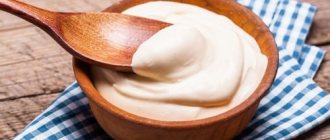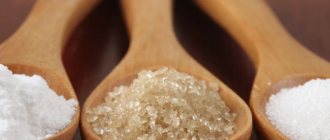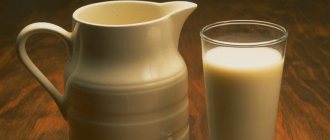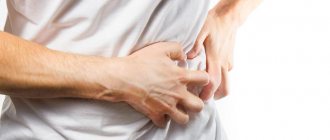Causes of diarrhea with pancreatitis
Doctors note that in acute pancreatitis, patients usually suffer from constipation.
Diarrhea most often occurs in the chronic form. The reasons are as follows:
- Insufficient amount of digestive enzymes.
- Exacerbation of other chronic diseases, for example, inflammation of the bladder or bile ducts.
- Impaired intestinal motility.
- Dysbacteriosis is the displacement of normal intestinal microflora by opportunistic microorganisms.
- Pancreatitis, which is a consequence of alcoholism.
Many diseases of the gastrointestinal tract are characterized by a similar clinical picture, which can periodically worsen or occur in a stable chronic form. Gastritis, cholecystitis, ulcerative lesions of the mucous membranes of the stomach and duodenum, and the progression of cholelithiasis are characterized by disturbances in the digestive processes.
- feces acquire a lighter shade, become greasy with a pasty appearance and have a strong fetid odor;
- stool may take on a green or yellow tint;
- polyfecalia develops, that is, an excessive level of fecal formation begins to predominate;
- pieces of undigested food predominate in the excrement;
- The onset of diarrhea begins almost immediately after eating food, along with the formation of nausea, rapid heartbeat and chills throughout the body.
In the absence of timely elimination of this pathology, the symptoms of diarrhea begin to progress further, which leads to the appearance of secondary symptoms associated with a deficiency of useful components in the body:
- dehydration develops in the body;
- there is a feeling of constant aching in the stomach;
- there is an increased level of patient weight loss;
- loss of appetite;
- the skin begins to peel off and acquires pale shades;
- the structure of nails and hair is disrupted;
- insomnia develops;
- The patient is constantly dominated by fatigue and weakness throughout the body.
Disturbances in the digestive system are the main symptoms of pancreatitis. Diarrhea makes itself felt with loose, mushy stools. Most often, the urge to have a bowel movement occurs some time after eating.
Diarrhea with pancreatitis is characterized by the following symptoms:
- Repeated bowel movements.
- Polyfecality - large volumes of feces.
- Light or grayish stool.
- Feces may not be easily cleared from the walls of the toilet.
- Presence of fat and shine in feces.
- Unpleasant smell.
- Leftover undigested food.
Yellowish, creamy stool is typical for patients who have been treated with antibiotics. But this may also indicate the development of related diseases, for example, disorders of bile secretion, pathologies of the liver and biliary tract.
As the situation worsens, other symptoms appear, such as dehydration, weight loss, lack of valuable components in the body, anemia, deterioration of hair, skin, and nails. Stress and psychological problems are also common.
Experts note that in the acute course of pancreatic disease, as a rule, patients complain of constipation. But diarrhea, on the contrary, accompanies the chronic form of pancreatitis. This happens for the following reasons:
- Lack of digestive enzymes.
- Exacerbation of other chronic diseases, for example, an inflamed bladder or liver bile ducts.
- Impaired intestinal motility.
- Displacement of intestinal microflora by opportunistic bacteria – dysbacteriosis.
- Alcohol factor in the appearance of pancreatitis.
Among the symptoms of chronic pancreatitis, the leading place is occupied by malfunctions of the digestive system. Diarrhea is manifested by loose stools with a pasty consistency. Most often, the urge to have a bowel movement occurs some time after finishing a meal.
What distinguishes diarrhea from pancreatitis:
- Repeated defecation.
- A large volume of stool is polyfecal.
- The color of the stool is light or gray.
- Feces are difficult to clear from the walls of the toilet.
- The presence of fats in the stool and the characteristic oily sheen of the stool.
- Foul smell.
- Fragments of undigested food.
The yellowish color of pasty stool is characteristic of patients who have undergone antibiotic therapy. However, this may also be a sign of the development of related diseases, for example, problems with bile secretion, pathology of the biliary tract and liver.
The results of the coprogram will indicate the presence of starch, fat, fiber and undigested fiber.
As the situation worsens, other signs will become more pronounced against the background of debilitating diarrhea:
- Anemia;
- Protein deficiency;
- Lack of vitamins;
- Dehydration;
- Sudden weight loss;
- Dry skin;
- Brittle hair and nail plates;
- The appearance of “jams” in the corners of the mouth;
- Inflammatory process of the tongue;
- Lethargy;
- Loss of concentration;
- Restless sleep;
- Quick change of mood.
Since diarrhea requires immediate removal to the restroom, patients with pancreatitis and those exhausted by diarrhea, in particular, find themselves unable to continue their normal lifestyle. Any public appearance can turn into an incident. Just the thought of this gives rise to complexes and psychological disorders.
Character
If you experience a strong urge to defecate some time after eating, you may have digestive problems. Pancreatitis can be distinguished from other pathologies of the digestive system by special features:
- Feces in chronic inflammation of the pancreas have a mushy consistency and a foul odor.
- Feces are colored light or gray. Yellow color is observed in patients who have been taking antibiotics for a long time. If the patient has not taken drugs of this group, it is necessary to undergo examination for the presence of pathologies of the biliary tract and liver.
- Repeated urge to defecate, incessant diarrhea, causing gaping of the anus.
- Diarrhea may be accompanied by nausea or vomiting.
- Polyfecality (large volumes of feces). Polyfecality indicates that most of the food eaten could not be absorbed. Often there are particles of undigested food in the feces. A greasy sheen in the stool indicates a large amount of fat. The results of the coprogram indicate the presence of undigested fibers, starch and fiber.
Due to a lack of vitamins and severe dehydration, a patient with pancreatitis loses weight. Hair and nails become brittle, skin becomes dry. The patient suffers from sudden mood swings. Apathy and insomnia appear.
Who to contact
Deterioration of the general condition against the background of exacerbation of pancreatitis and the appearance of constant diarrhea, which is accompanied by pain, requires immediate treatment at the hospital and full treatment in a hospital setting.
If the patient has a chronic form of pancreatitis, then if loose stools occur periodically, it is best to consult a qualified gastroenterologist who will prescribe the necessary studies and subsequent therapy for recovery.
Characteristic symptoms
Most diseases affecting the digestive organs periodically worsen or are chronic. They all have similar symptoms. For example, with pancreatic cancer, cramps and pain in the abdominal area during bowel movements are also felt, and general malaise appears.
Diarrhea caused by inflammation of the pancreas has its own characteristic features:
- Frequent stools are light/white in color. Its consistency becomes greasy, more like a paste, and has an unpleasant odor. Also, feces can become green or yellow in color. In rare cases, bloody diarrhea appears. The change in stool color is due to enzymes and toxic elements that are released and remain in the gland. For example, the fermentation process is provoked by special bacteria, resulting in a change in the color of feces.
- An abnormally large amount of feces is passed.
- Undigested food in the feces is a fairly clear sign of pancreatitis. This occurs due to impaired fermentation, which does not contribute to normal digestion and full absorption of beneficial elements.
- Diarrhea due to inflammation of the pancreas begins almost immediately after a meal (1-2 hours), accompanied by an attack of nausea, chills, and tachycardia. In advanced cases, loose, multiple stools occur daily.
If pancreatitis is not treated and diarrhea progresses, other signs of pathology will appear, indicating a lack of useful elements in the body:
- Aching, unpleasant sensations in the pancreas, abdominal pain.
- Anemia.
- Noticeable decrease in body weight.
- Lack of appetite.
- Dehydration (dehydration) of the body.
- Peeling, pale skin.
- Weakness and fragility of nail plates and hair.
- Sleep disturbance.
- Constant lethargy, drowsiness, powerlessness.
A patient with this disease experiences an increase in body temperature, cold sweat on the forehead and back, darkening of the eyes, constant attacks of painful nausea, and yellowing of the skin. Diarrhea with pancreatitis can cause poor concentration, sudden mood swings, and angular stomatitis.
Risk factors
Risk factors for diarrhea with pancreatitis are as follows:
- Pathologies of the abdominal organs of a viral, bacterial and parasitic nature, provoking a violation of the intestinal microflora.
- Vascular diseases that affect the kinetic function of the digestive organs.
- Injury to the pancreas due to impact, injury or surgery.
- Diseases of the gallbladder, liver, biliary tract, including the presence of stones.
- Use of strong medications and allergies to medications.
Forecast
If you follow all the specialist’s recommendations, the right habits will form, and over time the unpleasant symptoms will disappear. But remember that eliminating diarrhea is not everything. It is more important to cure the disease itself.
Diarrhea with pancreatitis is a kind of signal of dysfunction of the pancreas. If it does not appear so often, then it can be quite easy to cope with the problem using only enzymes and herbs. If the diarrhea is chronic, then more serious measures are needed.
The earlier therapy is started, the higher the likelihood of successful elimination of the pathology. Therefore, you should not ignore the symptoms of pancreatitis. When they first appear, you should consult a doctor.
Nutrition correction
After you manage to stop the exacerbation, you can start eating food, but in small portions, 5-6 times a day. It is better to avoid hard-to-digest foods, coarse fiber in the form of barley and beans, for example. The pancreas cannot cope with them. A fairly long list of products is prohibited.
- Alcohol.
- Fatty meat - pork, lamb, goose, duck. Any animal fats, fatty broths from these meat products, as well as first courses prepared from these broths.
It is prohibited to drink carbonated drinks if you have pancreatitis.
- Fatty fish and broths made from them.
- Smoked meats, sausages.
- Roast. Even potatoes.
- Eggs in any form.
- Spicy vegetables, seasonings, sauces.
- Canned food, marinades.
- Legumes.
- Mushrooms.
- Cocoa, coffee, soda.
- Fresh wheat bread. Bakery products must be at least yesterday's.
- Sweets, including fruits containing glucose.
The diet for pancreatitis with diarrhea should be as gentle as possible. Food should be liquid or semi-liquid with minimal fat content. Such food is easier to digest and replenishes fluid loss due to diarrhea. Fruits and vegetables must be subjected to heat treatment - boiling, baking.
Patients with pancreatitis should completely exclude egg dishes from their diet.
After you manage to relieve the acute symptoms of pancreatitis, you should stick to the diet for at least six months. And in the future, the mentioned products should become the exception rather than the norm in the diet. The fact is that pancreatitis is not completely cured. Diet and treatment only bring the pancreas into remission.
Diet for pancreatitis is an essential component of restoring function after an acute attack or exacerbation of a chronic form of the disease. You should avoid foods and drinks that require high enzyme activity for their absorption.
Semi-finished products and food from fast food chains are mandatory. Selectivity also applies to homemade food. For example, you should never eat anything cooked in oil, seasoned with spices, pickled or smoked. Fatty foods coupled with alcohol are enemy number 1.
Fractional six to eight meals a day is what an inflamed pancreas needs for the speedy regeneration of damaged tissues. The fact is that such frequent meals lighten the load on the pancreas during digestion. In addition, small portions are meant. Take your palm as a guide. The serving size should not exceed your handful.
Prevention
Indigestion with pancreatitis is a signal that the disease has become chronic and continues to progress. At the same time, the condition of the pancreas is such that it cannot fully perform its functions. The digestive process suffers more and more every day.
To prevent diarrhea due to pancreatitis, you should:
- quit smoking and do not drink alcoholic beverages in any quantities;
- do not overeat, always monitor your state of health during snacks;
- consume sweet foods, salty and peppery foods to a minimum;
- do not eat confectionery;
- It is best to eat crushed foods, steamed or boiled;
- use softly ground fresh vegetables and fruits as snacks;
- monitor your weight;
- exercise physical activity (fast running, working out in the gym, swimming, gym, etc.);
- Constantly undergo examination by a gastroenterologist and follow all his recommendations.
Pancreatitis is a fairly serious disease that leads to indigestion in some cases. To cope with this problem, you need to follow a diet that excludes the consumption of a number of foods. You should also watch your weight and not overeat. At the first signs of diarrhea, you need to consult a doctor, undergo a series of diagnostic procedures and receive adequate treatment.
Acute and chronic pancreatitis occurs with disruption of the gastrointestinal tract. Each form of the disease is characterized by its own disorders: constipation indicates an acute inflammatory process, and diarrhea with pancreatitis indicates a chronic form of the disease.
Fortifying medications to stop diarrhea
Medicines such as Imodium or Loperamide are designed to slow down the passage of intestinal contents. A personally prepared decoction of pomegranate peels is also famous for its strengthening effect. Homemade walnut tincture has a similar effect.
Among the side effects of taking the above-described recipes and medications is the risk of intoxication and the development of putrefactive processes, which can be triggered by attempts to retain food gruel, which was also poorly digested.
Fighting dehydration
Frequent diarrhea soon leads to dehydration, which negatively affects not only the health of the pancreas, but also the body as a whole. If there were more than 10 bowel movements per day, urgent hospitalization of the patient is required. First of all, he will be helped through IVs. Intravenous fluid administration involves turning to solutions of magnesium, sodium, potassium and other electrolyte salts.
If there is no need for hospitalization, doctors strongly advise drinking plenty of fluids. At least a day you need to drink 2 liters of clean boiled or filtered water. It is water, and not other drinks (tea, juice, decoction, jelly, compote, etc.), which will be classified not as a liquid, but as a food component of feces.
This does not mean that food and drinks are excluded. If the doctor has not warned you about therapeutic fasting, then nutrition is necessary. However, two liters of water is a rule that cannot be broken, no matter what.
How to stop diarrhea with pancreatitis
A disease such as pancreatitis occurs when there is a malfunction of the pancreas. Often the course of the disease is accompanied by defecation disorders.
When the disease is acute or aggravated, doctors and patients note the presence of constipation. Diarrhea with pancreatitis may indicate that it has entered a chronic stage.
A patient who has pancreatitis knows that the pancreas is not working well. Enzymes are either secreted in insufficient quantities, or they do not enter the duodenum, but remain in the gland and digest its tissues.
This means that the food that has entered the stomach is partially broken down, and the remaining volume begins to rot and ferment in the intestines. This environment is also favorable for the development of pathogenic bacteria. As a result of all these changes, diarrhea or diarrhea occurs.
Doctors identify several causes of defecation disorders:
- Decreased tone of the walls of the gallbladder and small intestine.
- Changes in the lumen of the biliary tract (blockage with stones or spasm).
- Exocrine pancreatic insufficiency.
- Insufficient amount of gastric juice and enzymes in it.
Consequences of diarrhea
Treatment of diarrhea with pancreatitis is simply necessary, because in some cases such a complication of pancreatitis can even lead to death. Frequent discharge of liquid stool leads to:
- Dehydration.
- Losing body weight.
- Vitamin deficiencies.
- Pallor of the skin.
- Lack of micro and macroelements.
- Intoxication.
- Nervous system disorder.
Why do such violations occur? Diarrhea with pancreatitis is a frequent urge to have a bowel movement. At the same time, the stool is very liquid, which means that a lot of water is removed from the body. This disrupts metabolic processes. As a result, vitamins and minerals are not absorbed properly, which means they pass through in transit, that is, they are washed out.
Since food is not digested, but rots and ferments in the intestines, the substances that are released as a result of these processes penetrate into the general bloodstream and can poison the body. Therefore, you need to consult a doctor in a timely manner to exclude intoxication.
In terms of weight loss, everything is clear. Food is not digested, which means it is not absorbed, but the body needs nutrients, so it uses its reserves. Fat deposits are the first to disappear, and then muscle mass, if this problem is not addressed in time.
How to treat
If you have diarrhea with pancreatitis, then you need to focus not on eliminating one symptom, but on completely curing the underlying disease. To do this, you must definitely contact a medical institution, where a qualified specialist will select all the necessary measures.
Diarrhea with pancreatitis requires treatment not only with medication, but also with dietary nutrition and adherence to the regimen.
Patients often ask the question, how to stop diarrhea with pancreatitis so that it does not cause such discomfort? Doctors recommend doing therapeutic enemas that will help flush out food debris and pathogenic bacteria from the intestines. To do this, dilute table salt (1.5 tablespoons) and baking soda (1.5 teaspoons) in 3 liters of water.
For an enema, adults use 2 liters of this solution, and children – 1 liter. To achieve the desired result, you need to do the procedure regularly for 4-10 days.
In addition, the doctor may prescribe medications that promote stool consolidation. But you need to be especially careful with them. Such medications reduce intestinal motility, which means food stays in the intestines for a long time. Considering the fact that the mass rots and ferments, the patient does not need this at all. The dosage of these medications should not be changed without the advice of a doctor.
No treatment is prescribed for diarrhea due to pancreatitis. It is aimed at restoring normal functioning of the pancreas. That is, it helps to release a sufficient amount of enzymes that will digest food.
Pancreatitis should be treated with a good balanced diet. All heavy foods are excluded (fatty, spicy, salty, fried). If you do not give up bad habits, you will not be able to overcome the disease. Alcohol consumption is especially dangerous.
It is important to eat food that will not injure the intestinal lining.
- Boil vegetables and make puree from them.
- Soups are preferably slimy and uncooked.
- Meat can be consumed only after the symptoms of exacerbation of pancreatitis have eliminated. But these should only be lean varieties and must be chopped (finely chopped or ground into minced meat).
- Jelly made from fresh sweet fruits and berries has a good effect on digestion.
- Milk can be added to soups or porridges. And it is desirable that it be low-fat, like other dairy products.
- The number of meals should be up to 6.
- Be sure to drink up to 2–2.5 liters of water, this is especially important when you have diarrhea. Drinking plenty of fluid will protect you from dehydration.
- You should not eat very hot or cold food. It should be warm.
If diarrhea appears, then beans, bran, mushrooms and foods high in fiber must be excluded from the diet.
You cannot fight this symptom on your own. You definitely need to see a doctor. Self-medication often aggravates the patient's condition. As a result, the duration of treatment increases.
Chronic pancreatitis is a progressive inflammation of the pancreas with periodic exacerbations and remissions, associated with the process of autolysis. It is quite often accompanied by diarrhea.
Diarrhea can be caused by many reasons. Among the main ones it is worth highlighting:
- dysfunction of the movement of pancreatic enzymes into the intestines;
- frequent consumption of alcoholic beverages (in large quantities);
- lack of digestive enzymes;
- impaired digestion of food due to excretory insufficiency;
- exacerbation of pancreatitis, frequent use of antibiotic drugs;
- problems with the functioning of the biliary tract;
- dysbiosis.
Feces with pancreatitis are mushy in shape and predominantly gray or light in color. But if you are taking antibiotics or have problems with your liver or biliary tract, your feces may have a yellowish tint.
Diarrhea with pancreatitis is characterized by a pungent and offensive odor. It may contain food particles, muscle fibers and the like. This signals a severe form of the disease.
Significant weight loss, dehydration, anemia - these are the main symptoms that clearly manifest themselves as a result of diarrhea.
You may also notice irritability and sleep disturbances. Diarrhea with pancreatitis leads to nervous disorders due to the instability of the usual lifestyle, so you still have to consult a specialist.
This is quite difficult, because you will need patience and compliance with all recommendations.
Diarrhea in chronic pancreatitis is treated comprehensively, since its development involves various mechanisms.
The main options for eliminating diarrhea are:
- cleansing enema;
- diet;
- medicines;
- restoration of water balance;
- probiotics;
- herbal treatment.
Enema
At first, an enema can help, as it flushes the intestines and gets rid of food particles that have been there for a long time. If you are afraid that it may harm the intestinal microflora, then it is in vain. It will not be able to remove all beneficial bacteria, but it will certainly eliminate harmful organisms.
Treating diarrhea with pancreatitis with an enema is as follows:
- the water temperature should be 38 degrees so as not to harm the body;
- a teaspoon of baking soda and a tablespoon of table salt are diluted in 2 liters of water;
- give 2-3 enemas in a row.
You can also use sea salt. The resulting solution should be used to treat the body for 4 to 10 days, 2 times a day.
With pancreatitis, as with other acute diseases of the pancreas, you need to be extremely careful with your diet. Especially when you have diarrhea.
The first thing that is recommended is to increase the amount of fluid consumed. The next thing is to eat crushed food so as not to cause pain in the stomach. The food should be warm. We must not forget that it is worth increasing the consumption of vegetables, as the body easily absorbs fiber. But vegetables must be boiled.
Foods containing proteins and fats should be removed from the diet as much as possible. It is not recommended to consume herbs, spices, carbonated and alcoholic drinks. Until the diarrhea goes away, you should not eat:
- meat products;
- sour cream with a high percentage of fat;
- radishes, radishes, garlic, onions, peppers and beans;
- mushrooms;
- sweets, chocolate, coffee and cocoa.
But buckwheat porridge is acceptable, since it is considered a dietary dish.
It is also worth remembering about your diet. You need to eat 7-8 times a day in small portions.
Medicines
When diarrhea appears due to pancreatitis, the questions “how to get rid of it, how to stop it?” Most people will answer that with medications. But you need to be careful with these medications and discuss treatment medications with your doctor. The main medicine is pancreatin.
To restore the water balance in the body, a solution of sodium, potassium, magnesium and other electrolyte salts is injected intravenously, but these are extreme measures. You can normalize the amount of fluid in the body by drinking 2-2.5 liters of water, not tea, compote, etc.
, because they are recognized as food.
The flora usually takes a long time to recover, but Bifilakt, Laktovit, Linex, Hilak, Enterozermina can help. There is also this option: we start treatment with colibacterin for 3 weeks, then take the same amount of bifidumbacterin, and finish with lactobacterin (take up to 3 weeks).
Herbal treatment
This method can be a complement to the above.
The most used collection option includes: peppermint (antispasmodic), chamomile (anti-inflammatory component), calendula flowers (antimicrobial), corn silk (choleretic). We take all the elements in equal parts and grind them.
Pour one spoon of the resulting mixture into a liter of boiling water. The collection should brew for an hour. Then we filter it and take 100 ml 15-20 minutes before meals, temperature -38-40 degrees.
Also don't forget about:
- decoction of pomegranate peels;
- horse sorrel tincture.
Treatment of diarrhea
Treatment of diarrhea with pancreatitis primarily involves stabilizing the functioning of the pancreas. And this is a very difficult process that requires self-discipline on the part of the patient. An exacerbation of pancreatitis, accompanied by acute pain, diarrhea, vomiting and fever, requires refusing to eat for a day or two, but at the same time it is necessary to drink more water, if possible mineral water.
During exacerbations, bed rest is indicated. It is suggested to place ice or a heating pad filled with cold water (+5-7 °C) on the pancreas area.
During an exacerbation of the pathology, the patient needs to drink plenty of fluids
Medicines for diarrhea prescribed for exacerbations of pancreatitis
Treatment of diarrhea due to pancreatitis involves treating the disease itself that caused the diarrhea. Therefore, in addition to stool-strengthening medications, others are prescribed. They are all reflected in the table.
| Group and purpose of drugs | Names of drugs | The purpose of medicines |
| Enzyme-containing drugs | Festal, Mezim, Pancreatin | Enzymes are delivered to the duodenum to help digest food, the load on the pancreas is reduced, and food digestion is improved. |
| Enterosorbents | Activated carbon, Polysorb, White coal, Almagel | Helps overcome body intoxication. |
| Analgesics, painkillers | Pentalgin, Tempalgin, Ketanov | Helps cope with pain during exacerbations of pancreatitis. |
| Antispasmodics | No-shpa, Papaverine | Eliminate spasms. |
| Combined-action drugs combining analgesics and antispasmodics | Spasmalgon Renalgan | Aimed at relieving acute spasmodic pain. |
| Antidiarrheal drugs | Imodium, Lopedium, | The drugs will help reduce the daily number of bowel movements and increase the tone of the rectum and anus. These medications are prescribed for pancreatic diarrhea. |
| Probiotics containing bifidobacteria and lactobacilli | Colibacterin, Bifidumbacterin | Restore intestinal microflora. |
As soon as diarrhea can be eliminated, it is recommended to include in the treatment complex drugs that replenish the deficiency of vitamins and minerals in the body.
Enema for cleansing
A completely illogical, at first glance, way to combat diarrhea is an enema. However, as doctors assure, it is quite effective. Since with pancreatitis food is poorly digested and its fragments begin to ferment and rot in the intestines, cleansing with an enema, at a minimum, takes place.
To prevent intoxication by decay products and restore intestinal microflora, an enema is given. You can also get rid of putrefactive microbes with tablets, but this is not recommended, so as not to additionally load the gland.
Complications and consequences
Regardless of the cause of diarrhea, the most serious consequence is dehydration. The color, type and smell of the discharge does not matter; it is enough that it becomes more liquid, and accordingly, the volume of water in it increases.
During the act of defecation during diarrhea, the body loses 2-3 times more water than usual. Considering that with prolonged pancreatitis, diarrhea is possible several times a day, fluid loss can be critical. It manifests itself as constant thirst and dry skin.
Along with water, necessary substances leave the body, which leads to disruption of the water-electric balance. Digestion and intestinal absorption are impaired, anemia, lack of protein and vitamins, and metabolic disorders are possible. The body's protective functions are reduced. Also, diarrhea with pancreatitis can provoke necrosis of organs with the development of their dystrophy.
Why is pancreatic diarrhea dangerous?
The danger of diarrhea with pancreatitis is dehydration. During one bowel movement with diarrhea, fluid is removed two to three times more than with normal stool. Patients experience thirst and dry skin. Patients lose minerals with water, resulting in an imbalance of electrolytes.
Violation of food digestion and absorption deprives the body of essential vitamins and microelements. Anemia develops. A person does not receive enough proteins necessary for building new tissues. Metabolism is disrupted.
A patient with pancreatitis suddenly loses weight. Lack of vitamins and calcium causes:
- looseness and softness of bones;
- deterioration of hair and nails;
- muscle weakness, trembling inside;
- inflammation of the tongue.
A person suffering from diarrhea due to pancreatic pathology becomes emotionally unstable, hot-tempered, and experiences mood swings and insomnia.
With severe inflammation of the pancreas, dystrophy and partial necrosis of internal organs - liver, gall bladder, etc. - are observed.
The immune system ceases to perform its protective functions, and the patient easily picks up viral infections. Frequent urges to empty the bowels tie the patient to the house, force him to withdraw into himself, and complicate his existence.
Probiotics
The next step after cleansing the microflora of microbes is to populate it with probiotics. Usually the enema is carried out in a course for seven days, and after five days they begin to take Colibacterin daily for three weeks. The next three weeks pass under the auspices of using Bifidumbacterin. As soon as it is completed, another 21 days of taking another drug - Lactobacterin.
The exact dosage of medications and frequency of administration are determined by the attending physician, based on individual indications.
Diarrhea with pancreatitis: herbal treatment
Herbal medicine against diarrhea is represented by anti-inflammatory, antibacterial, antispasmodic and choleretic plants. The collection is based on chamomile, calendula, mint and corn silk as the main components. They are mixed in equal proportions and poured with one liter of boiling water. It is recommended to infuse for one hour, after which the drink is carefully filtered through a sieve or gauze folded in several layers.
Approximately a quarter of an hour before meals you need to take 100 ml of warm, but not hot, infusion. The optimal temperature is 39 degrees. The course of treatment is 1.5 months.
To prevent the development of multihypovitaminosis, take multivitamin complexes in addition to all of the above measures to combat diarrhea. Be healthy!
Where is the pancreas located in a person, its functions, and how it hurts.
Main signs and symptoms of pancreatitis
Pancreas size in humans, normal in adults and structure of the organ: head, body, tail.
What is pancreatitis - answers from leading gastroenterologists to patients' questions.
Diet for pancreatitis of the pancreas as the main factor in successful treatment.
Folk recipes
Decoctions help combat diarrhea caused by inflammation of the thyroid gland:
- pomegranate peel and partitions,
- horse chestnut and walnut leaves. To prepare a decoction, it is better to take these leaves together, since walnut leaves contain a large amount of iodine, which can destabilize the thyroid gland.
A mixture of fresh juices from potato and carrot tubers will have a sedative and restorative effect on the mucous membranes. It’s a good idea to start eating with them after forced fasting during exacerbations of pancreatitis. And then take 1 glass 3 times a day about half an hour before meals.
Immortelle infusion will help stop diarrhea
Herbs for diarrhea also have a good effect:
- A mixture of calendula flowers, chamomile and corn silk will work as an anti-inflammatory and anti-diarrheal agent. For 1 glass of boiled water, take 1 tablespoon of the mixture, infuse for 40-50 minutes in a warm place and take a quarter of an hour before meals. The glass can be divided into 2-3 times and drunk throughout the day. It is recommended to drink the infusion from this collection for a month.
- Wormwood is a very powerful herb in the fight against any form of diarrhea and some inflammations. However, you should not take it more than once a day. A decoction is prepared from wormwood at the rate of 1 tbsp. spoon for 1 glass of boiling water. The herb poured into the water must be allowed to boil and leave for 30 minutes. Then filter the broth, squeeze and add boiled water to the glass. Take one quarter glass 2 times a day. One glass of decoction is enough for 2 days.
- Immortelle is also taken in the calculation of 1 tbsp. spoon per glass of boiling water. Leave for half an hour and take 0.5 cups 3 times a day.
Before starting treatment with one or another herbal collection, you should consult your doctor.
From the video you will learn why diarrhea occurs with pancreatitis and how to treat this condition:
Diagnostics
Diarrhea with pancreatitis most often indicates that the disease is becoming chronic. The sooner you see a doctor, the better. If inflammation of the pancreas is suspected, diagnosis includes examination with palpation of the epigastric region, study of symptoms, and sometimes temperature measurement.
The following tests are prescribed:
- general blood analysis;
- blood test for glucose;
- general urine analysis;
- stool analysis.
Also, if pancreatitis is suspected, laboratory diagnostics of the functioning of the pancreas is performed. For this purpose, a special urine or blood test for enzymes is prescribed.
Instrumental diagnostics makes it possible to assess the size of organs and the processes that occur in them. Ultrasound of the pancreas remains the most informative and popular diagnostic method. More modern techniques are computed tomography and magnetic resonance imaging, which make it possible to examine the pancreas in as much detail as possible.
Differential diagnosis is carried out with inflammation of the gastrointestinal tract (gastritis, colitis, duodenitis), intestinal infections, and intoxications.
conclusions
One of the symptoms of chronic pancreatitis is diarrhea. It can become protracted, which sharply worsens the patient’s condition and negatively affects his quality of life. But self-medication in cases of acute or chronic inflammation of the pancreas in the acute stage is unacceptable. An advanced disease can be fatal. Competent, comprehensive, complex treatment of pancreatitis and the diarrhea caused by it is possible only in a specialized hospital under the supervision of doctors.
We recommend: What to do if your baby has diarrhea with mucus?
Reviews
Reviews about the elimination of diarrhea during pancreatitis are of a different nature, since many achieved a positive result, while some, on the contrary, did not achieve the expected effect. In this case, the treatment method largely depends on the severity of the disease.
At first I didn’t pay attention to the loose, green stool, but the pathology began to recur. At the same time, there was pain in the left side. The examination showed the initial stage of pancreatitis. I underwent treatment and now have revised my diet and lead a healthy lifestyle.
Svetlana, Kirov
I have chronic pancreatitis, so I am familiar with diarrhea firsthand. The best method of elimination is to follow a diet and avoid eating large amounts of food in the first days of an exacerbation. When improvement occurs, you can slowly adjust your own diet.
Irina, Saransk
Features of the flow
Jaundice is one of the signs accompanying diarrhea
Liquid stools with pancreatitis persist for 3-5 days. During this time, the patient can visit the restroom up to 10 times a day. Feces have a grayish tint, a foamy consistency, and are poorly washed off from the earthenware surface (steatorrhea).
Along with diarrhea, the patient has the following symptoms:
- thirst;
- pain in the upper abdomen (more precise localization depends on which part of the gland is affected);
- bloating;
- nausea;
- belching;
- vomit;
- loss of body weight by several kilograms by 2-3 days.
The severe course of the disease may be accompanied by the development of mechanical jaundice. The condition develops if a swollen and enlarged gland compresses the central bile duct. In this case, the release of bile is disrupted, and it begins to be absorbed into the blood with the development of hyperbilirubinemia.
Diarrhea with chronic pancreatitis can occur outside periods of exacerbation. Moreover, it occurs without accompanying symptoms and disappears within 2-3 days, even without pharmacological correction.









